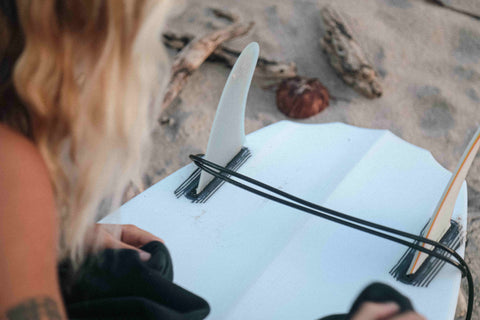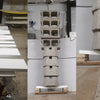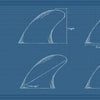How to choose your surfboard - part 1

Surfing is an exhilarating sport that allows you to connect with the ocean and ride the waves. Choosing the right surfboard could make a huge difference in your surf journey, building your style, how you surf and ultimately make it fun or frustrating. It's important to understand the different components that make up a surfboard to ensure that you pick the right one for your skill level and style. In this first post of this serie, we'll talk about the basic of the outline, rocker, foil, rail, tail, and fin setup to help you choose the perfect surfboard. Those will set the bases for the nexts blogs that will go deeper in who should ride what type of board.

The Outline
The outline of the surfboard refers to the shape and size of the board. The outline is generally defining the type of board (longboard, performance shortboard, retro fish, hybrid, funboard...) A general rule of thumb is that the longer and wider the board, the easier it is to catch waves and stand up. That's what you want when you get started. However, if you're looking to progress in your surfing and perform more advanced maneuvers, a shorter board with a narrower outline may be more suitable.

The Rocker and Foil
The rocker of a surfboard refers to the curve of the board from the nose to the tail. A board with more rocker will be more maneuverable in steeper waves, while a flatter rocker is better for small waves and speed. When choosing the right rocker, consider the types of waves you'll be surfing in and your surfing goals.
The foil of a surfboard refers to the thickness and distribution of foam on the board. A thicker foil provides more flotation and stability, while a thinner foil provides more maneuverability. Consider your weight and skill level when choosing the right foil for your board. A thicker board will provide more floatation at low speed, but the extra foam will make the board heavier
when it’s planning and is out of the water.

The Rails
The rails of a surfboard refers to the edge of the board that makes contact with the water. A soft and boxy rail (more round overall) provides more forgiveness and is better for beginners and stability while a hard and pinchy rails will provides more precision control more planning area and is better for advanced surfers. (This will be the subject of one of the logposts of this series stay tuned). Consider your skill level and the types of waves you'll be surfing when choosing the right rail.

The Tail and Fins Setup
The tail of a surfboard affects greatly its performance and maneuverability. A narrow tail will sink more in the water offering stability, but also will be easier to move from rail to rail and will work better in more powerful surf. A wide tail will offer more floatation and planning area and will tend to preform better in smaller waves. Fish tail, square, diamond tail with sharp exit will allow water to be disrupt fast from the board offering more speed while rounded tail outline will make water following the tail and offering more stability and a bit less speed.
The fin setup also plays one of the biggest role in the board's performance, with a thruster setup providing more speed control and pivot of the back fin. The quad setup will generally be faster, with more release and will be great to hold when you’re engage on your rail. Twinfin will be similar to quad. There is so many different fins templates and they all provide their own performance and feel that this is a long subject to cover, but keep in mind that fins are super important and having the right or wrong fin could make your board alive or dead.
Conclusion
Choosing the perfect surfboard is a personal decision that depends on your skill level, surfing goals, and the types of waves you'll be surfing. By understanding the different components that make up a surfboard, such as the outline, rocker, foil, rail, tail, and fin setup, you can make an informed decision and avoid costly mistakes. Remember to choose a surfboard that suits your individual needs and preferences to enhance your surfing experience and progress in the sport.
If you have any questions reach to us by email or instagram!
Happy surfing!




